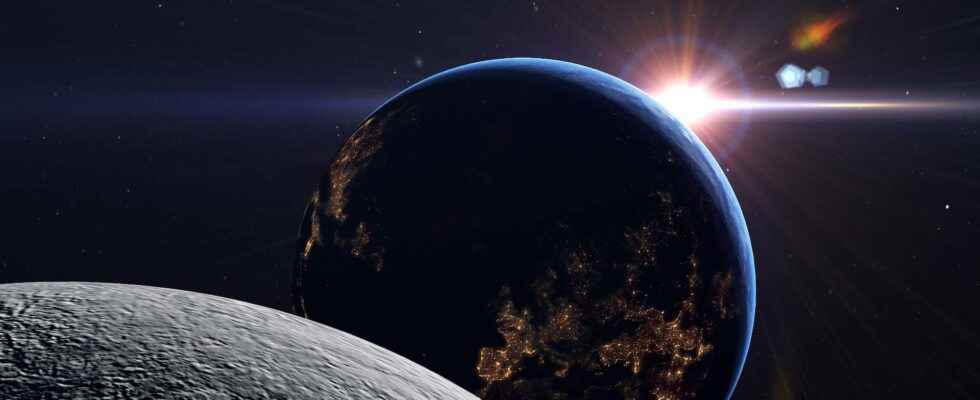You will also be interested
[EN VIDÉO] Direct observation of the formation of an exomoon The giant Alma radio telescope has taken the first direct image of a moon forming around a very young giant planet.
Within the Solar System, the Earth has many particularities. One of them is having a relatively large moon. Our Moon indeed reaches about 1% of the mass of the earth. An exceptional size for a satellite. All the others moons of the solar system, including the moons of giant planetsare indeed less than one ten-thousandth of the mass of their planet, with the exception of Charon, which weighs 12% of the mass of Pluto. What could have allowed this specificity?
As a reminder, the Moon was formed during of a gigantic impact between a planetary body and the primitive Earth. For scientists, this collision is certainly one of the explanations for the exceptional size of the Moon compared to the Earth. However, this does not explain everything. Because large collisions of this type were legion at the beginning of the formation of the Solar System. And yet the moons of Mars, Jupiter, Saturn, Uranus and Neptune are relatively small in size. To note that Mercury and Venus do not have a natural satellite.
Small planets to form large moons
The diversity of moons that we observe in our Solar System is indeed the result of the diversity of the processes leading to their formation. Because not all are the result of a collision. Most of the natural satellites like the moons of Jupiter or Titan, the moon of Saturn, condensed from a disc of matter residual following the formation of their home planet. Moons of Mars (Phobos and Deimos)as well as Neptune’s moon (Triton), would in fact be rocky bodies captured by the gravitational field of these two planets, even if this hypothesis is discussed. Only our Moon and Charon would come from the debris of major impacts with protoplanetary bodies.
In an article published in NatureCommunicationsa team of scientists observed the formation of moons after such an impact, thanks to the Numerical simulation. In particular, they studied the influence of different parameters, such as the nature of the planetary bodies colliding, as well as their respective masses.
The researchers have thus shown that during a major impact, only the rocky planets less than six times the mass of Earth and icy planets less than one Earth mass can form a relatively large moon.
The limiting factor: the amount of gas in the debris disk
In their simulations, the scientists modeled several types of collisions: between two rocky protoplanets or between two icy protoplanets. These two types of planets differ in their compositions. Rocky planets contain a core of iron and one coat silicate, whereas icy planets have a silicate core and a mantle composed mainly of water ice. The simulations show that in each of the two cases, the collision generates a cloud fine particles and gaswhich will then condense to form a new body, a moon.
However, the values of the colliding masses play an important role on the final result. It appears that for rocky planets (also called telluric) six times heavier than Earth, the moons resulting from the collision will be relatively small. The same is true for icy planets with a mass greater than once that of Earth. Only values below these masses can lead to the creation of relatively large moons, at least a few percent of the mass of the parent planet. One of the limiting factors to the creation of large moons seems to be the amount of vapors (of silicate or water depending on the type of planet) present in the debris disk.
Indeed, a disc composed mainly of gas will not lead to the formation of a moon. In the case of very massive planets, the debris will thus quickly fall back on the planet before they could form a moon. Conversely, for smaller planets, such as Earth, the lower amount of gas allows different materials to gravitate around each other, eventually leading to the formation of a large moon (simulation below).
Simulation of the formation of a large moon. © AGU, YouTube
These results help to understand the evolution of the Earth-Moon couple and provide research leads for the detection of potential “exomoons” around planets with a mass close to that of the Earth.
Interested in what you just read?
